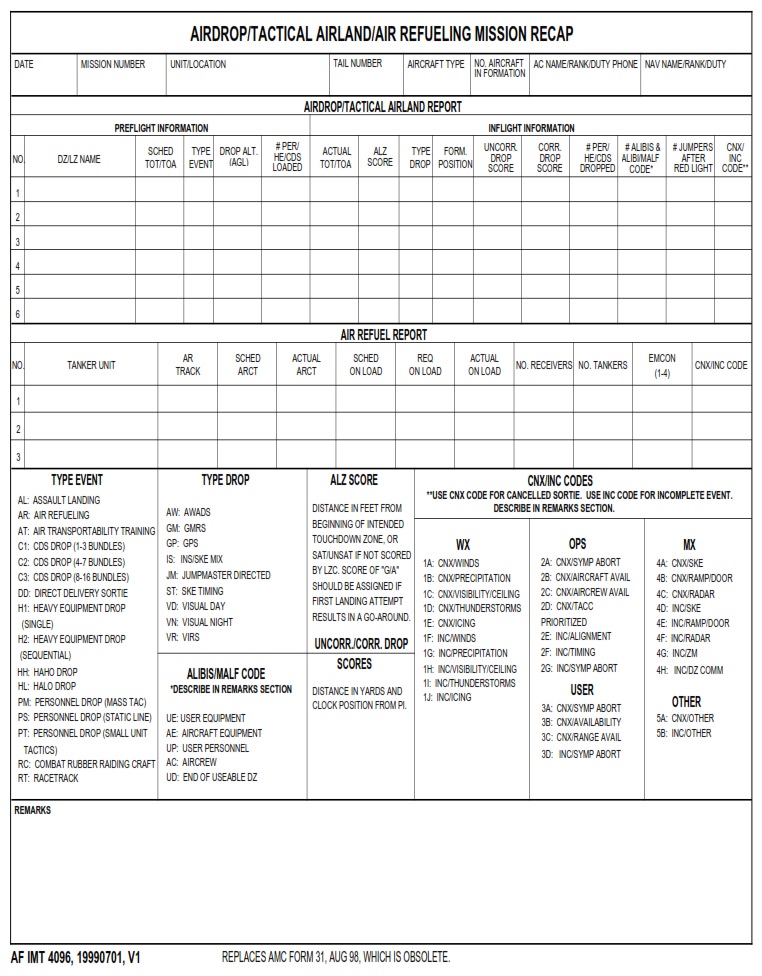AF-FORMS.COM – AF Form 4096 – Airdrop/Tactical Airland/Air Refueling Mission Recap – In the world of military aviation, precision and coordination are paramount. Imagine an operation where aircraft must seamlessly execute airdrops, tactical airland missions, and air refueling all within a single high-stakes mission. This is where the AF Form 4096 comes into play – a vital tool for capturing the intricate details of these complex endeavors. As we delve into the intricacies of this form and explore the adrenaline-pumping world of aerial missions, we uncover a fascinating blend of strategy, skill, and split-second decision-making that keeps our armed forces at the forefront of global defense.
From calculating drop zones to tracking fuel consumption during mid-air refueling, each box on AF Form 4096 represents a crucial piece in the puzzle of modern aerial warfare. Join us as we unravel the gripping narrative behind these missions and gain insight into the meticulous planning and execution required to ensure success in this dynamic realm. With its intersection of technology, human expertise, and unwavering dedication to national security, this article invites you to step into the cockpit alongside our service members as they navigate through unparalleled challenges in defense of freedom.
Download AF Form 4096 – Airdrop/Tactical Airland/Air Refueling Mission Recap
| Form Number | AF Form 4096 |
| Form Title | Airdrop/Tactical Airland/Air Refueling Mission Recap |
| Edition Date | 7/1/1999 |
| File Size | 49 KB |
AF-Form-4096-Airdrop-Tactical-Airland-Air-Refueling-Mission-Recap.pdf (19 downloads )
What is an AF Form 4096?
The AF Form 4096, also known as the Airdrop Tactical Airland Air Refueling Mission Recap, is a crucial document used by the U.S. Air Force to record and report details of airdrop, tactical airland, and air refueling missions. This form serves as a comprehensive record of mission-specific information such as aircraft type, mission number, drop zone location, cargo weight and type, personnel involved, weather conditions, and any unusual incidents or malfunctions encountered during the mission. By meticulously documenting these details, the AF Form 4096 ensures accountability and allows for a thorough analysis of each mission’s performance.
Furthermore, the AF Form 4096 plays an essential role in enhancing operational efficiency and safety measures within military aviation. As this document captures vital data related to a wide range of aerial operations, it provides valuable insights for improving training programs and refining operational procedures. In addition to its practical applications in mission planning and execution, the meticulous recording of every aspect of an operation through this form contributes significantly to knowledge management within the U.S. Air Force’s aviation division. Ultimately, the AF Form 4096 not only functions as a piece of administrative paperwork but also serves as an indispensable tool for driving continuous improvement in air mobility capabilities while upholding strict adherence to safety standards.
Where Can I Find an AF Form 4096?
If you’re wondering where to find an AF Form 4096, the answer lies within military channels. Typically, the form is available through official military logistics and supply systems, often accessible by authorized personnel within the Air Force. It’s important to utilize specified channels and resources to obtain this form due to its sensitive nature and critical relevance to airdrop tactical airland air refueling missions. Accessing it through proper military channels ensures adherence to security protocols and operational requirements.
Additionally, it’s worth noting that the digital landscape has revolutionized document accessibility within the military. Many forms, including AF Form 4096, can now be obtained electronically through secure databases and digital platforms designated for military use. This technological advancement has streamlined processes and improved efficiency in managing mission-critical documents like AF Form 4096. By leveraging digital resources, personnel involved in airdrop tactical airland air refueling missions can access necessary forms with greater speed and convenience while upholding rigorous security standards.
In conclusion, understanding where to find an AF Form 4096 entails recognizing the importance of adhering to established military procedures for documentation retrieval. Additionally, embracing technological advancements in document management further enhances access and operational effectiveness. With these insights in mind, members of the Air Force involved in airdrop tactical airland air refueling missions can ensure they have timely access to pertinent forms essential for mission success.
AF Form 4096 – Airdrop/Tactical Airland/Air Refueling Mission Recap
AF Form 4096, commonly known as the Airdrop Tactical Airland Air Refueling Mission Recap, plays a pivotal role in recording essential details of air operations. This comprehensive form captures critical data on airdrop missions, airland operations, and air refueling activities. The meticulous documentation of mission-specific information, such as aircraft type, cargo weight, drop zone characteristics, and fuel consumption during air refueling, enables accurate analysis and evaluation of operational effectiveness.
Furthermore, the AF Form 4096 serves as a valuable tool for post-mission debriefings and performance assessments. By documenting detailed accounts of mission execution and logistical support processes, this form facilitates the identification of operational strengths and areas for improvement. The insights derived from analyzing these recaps not only enhance current operations but also contribute to the development of more effective strategies for future missions. Ultimately, the AF Form 4096 not only streamlines record-keeping but also provides vital insights that drive continuous optimization within Air Force operations.
In conclusion, the AF Form 4096 – Airdrop Tactical Airland Air Refueling Mission Recap acts as a crucial document in ensuring operational efficiency and success within aviation missions. Its meticulous capture of mission-related data coupled with its role in facilitating post-mission evaluations makes it an indispensable tool for enhancing Air Force capabilities.
